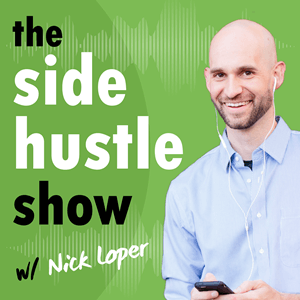
Let’s look at 10 popular passive income ideas to see which ones might actually make sense for you.
To help me do it is Mr. Smart Passive Income himself, Pat Flynn from Smart Passive Income.
Nobody had a bigger influence on the creation and early years of Side Hustle Nation than Pat. It’s always fun to have him back on the show, especially with his new book coming out this week: Lean Learning: How to Achieve More by Learning Less.
We went idea by idea and gave each one a score from 1 to 10.
Some of them surprised us, and a few may have outlived their usefulness.
Tune in to Episode 675 of the Side Hustle Show to learn:
- which passive income ideas are actually worth your time (and which to skip)
- a real-world business ideas you can start fast
- the marketing tactic, tool, and book Pat Flynn is using right now
Sponsors
- Mint Mobile — Cut your wireless bill to $15 a month!
- Indeed – Start hiring NOW with a $75 sponsored job credit to upgrade your job post!
- OpenPhone — Get 20% off of your first 6 months!
- Shopify — Sign up for a $1 per month trial!
Round 1: Grading 10 Popular “Passive Income” Ideas
1. Book Publishing – Score: 2/10
I’ve seen this model work in a few different ways. But from a passive income perspective, Pat said it’s probably not where you’d like to start.
Writing a book is a long adventure. In fact, Pat spent two and a half years on his latest one. It takes a ton of effort, and unless you already have an audience, the sales on their own usually aren’t life-changing.
That said, a book can be a powerful asset if it leads somewhere. It can open doors to speaking gigs, build credibility, or be a stepping stone into something more scalable, like an online course or coaching program.
Royalties might trickle in over time, though, (Pat still earns from Will It Fly and Superfans), but for most people, the book itself won’t be the cash cow.
2. Online Courses – Score: 7/10
Online courses still check a lot of the passive income boxes: create once, sell over and over.
But things have shifted. When we first got into this space, packaged information had real value. Today, information is everywhere (often for free), so if your course is just a collection of generic content, it’s going to be a hard sell.
The courses that do well now are either super specific to a niche or backed by a strong personal brand. What we’re seeing more of, too, is a shift from evergreen, self-paced courses to cohort-based models.
These group experiences add accountability, coaching, and a sense of community, so students stick with it and actually get results.
3. Blogging – Score: 1/10
This is a bit sad, but we get it.
It’s just gotten way harder to get traction with a traditional blog with all the algorithm changes, AI summaries taking over search results, and Reddit dominating page one of Google.
It doesn’t mean blogging is dead.
There are still creators crushing it with text-first content… but most are leaning into newsletters, Substack, Kit, or other platforms that give them more control and better distribution.
4. Real Estate – Score: 6/10
Real estate’s always been a fan favorite. And yeah, there’s potential for cash flow, appreciation, and tax perks. But it’s not as hands-off as people like to believe.
According to Pat, he’s tried single-family rentals and found the fees, management headaches, and general slowness of it all just weren’t for him.
But real estate can absolutely be part of a long-term wealth strategy, especially if you love the game and want to scale.
We’ve featured some fun, unconventional rental businesses on the show: bounce houses, photo booths, mobility scooters, even portable hot tubs.
5. E-commerce – Score: 7/10
This is another “create once, sell over and over,” but how passive it really is depends on how you set it up.
Pat and his videographer Caleb created the SwitchPod, a handheld tripod for creators, and launched it on Kickstarter back in 2019. It raised over $400k in the first 60 days.
But getting there took a lot of time, money, and trial and error. So definitely not an overnight success.
Today, the SwitchPod still sells through their site and Amazon, and they use a third-party logistics company (3PL) to handle fulfillment. That keeps it semi-passive.
That said, you don’t have to invent something from scratch. White-labeling existing products, adding your own brand, and targeting a specific niche can be much faster.
6. Software & Apps – Score: 9/10
Once it’s built, the product costs almost nothing to deliver, and you’re not trading time for money. That said, it’s not without risk. Pat shared how he sunk $20k into a WordPress plugin back in the day without validating the idea. It never even made it to market.
If the idea of building software feels out of reach, go check out my episode with Pete McPherson. We talked all about using AI tools and no-code platforms to create functional apps without writing a single line of code.
Of course, software still needs maintenance. Servers crash, bugs pop up, and you’ll want to keep things fresh. But when you compare it to most other income streams, it’s one of the most scalable and flexible out there.
7. Product Licensing – Score: 6/10
This one’s probably the most passive idea we talked about. Create an idea, license it to someone else, and let them do the heavy lifting.
Just like what the guy did behind Teddy Ruxpin, the talking bear from the ’80s.
There’s also a newer take on licensing: instead of physical products, people are licensing content. E.g. course creators licensing their training material to companies for employee onboarding.
And if you’re the “ideas person” but don’t want to deal with inventory or Amazon FBA headaches, this route can make a lot of sense. Stephen Key from InventRight teaches a lot on this.
8. YouTube – Score: 9/10
Pat started a Pokémon channel in 2021, Deep Pocket Monster, just for fun with his kids.
Fast forward to today: 1.7 million subscribers, nearly a billion views, and a five-figure monthly income from what he calls “opening shiny cardboard.”
It’s not totally passive, though. Pat still spends about a day and a half a week working on it. But the thing is, the content is evergreen. One video he shot in 2022 has pulled in over $100k in ad revenue—just one video.
So even if he stopped today, he’d likely keep earning from past uploads for a while.
9. Affiliate Marketing – Score: 10/10
You don’t need your own product. You just need to genuinely recommend something useful to your audience.
Pat shared a great example: he created a YouTube tutorial on how to use Descript, dropped his affiliate link, and that one video has now brought in over $100k in commissions. Still earning, years later.
Or Matt Wolfe with ThriveCart.
Same goes for tools like Canva, Kit, or any software with recurring plans — people sign up once, and you keep getting paid.
Affiliate marketing can also lead to deeper partnerships. Pat’s now an advisor or even part-owner in some of the companies he started out just promoting.
10. Advisorships – Score: 7/10
This one’s not as common, but advisorships are kind of like behind-the-scenes consulting: offering feedback, introductions, or strategic input to companies in exchange for equity.
Pat’s now an advisor to 12 different companies, and while most of them don’t pay regular cash, he’s gotten six-figure checks when some of those companies sold or were acquired.
It’s also not very busy. Maybe a monthly call, sometimes a trip or a brainstorming session. And if you’re already an affiliate or power user of a tool, this can be a natural next step.
Round 2: Donate a Business Idea
If Pat had more time, or needed fast cash, he’d start a garbage can service. Just moving bins to and from the curb on trash day. Simple, recurring, and surprisingly sticky. He saw someone charging $50–$100/month for it.
There was also a kid in his neighborhood offering $20 to replace broken bins, and showed up 15 minutes later with a new one.
We also tossed around ideas like trash can cleaning and even starting your own garbage route. Not glamorous, but solving recurring problems = recurring revenue.
Round 3: The Triple Threat
1. Marketing Tactic
Pat’s been leaning hard into short-form video in a series. For his new book, he did a 21-day video lead-up to launch day — one short per day, each building anticipation.
The secret is in the momentum: people come back not just for the content, but to see what happens next.
He pointed to other creators using the same format, like Bryson DeChambeau chipping golf balls over his house daily, or the guy sailing from Oregon to Hawaii one day at a time.
Even Jaclyn Mitchell, who posted daily about her “$100 a day for 100 days” challenge, turned it into real income and new opportunities.
2. Favorite Tool Right Now
Pat’s been experimenting with Poppy AI, a visual content dashboard where you can connect your own assets (newsletters, PDFs, YouTube videos) and use them to train the tool.
From there, it helps you write in your own style, remix ideas, or even plan something bigger like a video essay. He’s using it to study what makes a great video essay tick, while building one for the Lean Learning launch.
3. Favorite Book
His top book this year is Buy Back Your Time by Dan Martell. It’s a hit for a reason.
The core message — focus on what matters now, outsource the rest — lines up perfectly with what Pat teaches in Lean Learning.
“The big thesis behind lean learning is we have to get away from just-in-case learning, and we need just-in-time learning.”
You can grab a copy or learn more at LeanLearningBook.com, and of course, catch more from Pat on the Smart Passive Income podcast.
Episode Links
- Smart Passive Income
- Lean Learning: How to Achieve More by Learning Less
- Smart Passive Income podcast
- Will It Fly
- Superfans
- Substack
- Kit
- SwitchPod
- Kickstarter
- Stephen Key from inventRight
- Deep Pocket Monster
- YouTube tutorial on how to use Descript
- Matt Wolfe with ThriveCart
- Bryson DeChambeau chipping golf balls over his house
- Guy sailing from Oregon to Hawaii (Oliver)
- Poppy AI
- Buy Back Your Time
- Lifestyle Creep, Luck, and Why Every Podcast Guest Has an Online Course: Q&A w/ Nick
- Is Business Coaching Worth It? (My 2024 Progress Report)
- Blogging in a Post-HCU World: The Savvy 7-Figure Online Business, with Kelan Kline
- Reddit Marketing: How to Drive Traffic from Reddit, with Amy Aitman
- 23 Best Real Estate Side Hustles to Build Wealth and Cash Flow
- How to Start a Bounce House Rental Business (Investing in “Inflatable” Real Estate), with Corey Jeffreys
- How to Start a Photobooth Company: 6-Figures in 18 Months, with Cat Bloch
- $3k a Month Renting Out Mobility Scooters Part-Time, with Lenny Tim
- How to Start a Hot Tub Rental Business: Zero to $1000s per Month, with Steve Nadramia
- How to Make $100 a Day on the Side for 100 Days: Real Life Results, with Jaclyn Mitchell
Looking for More Side Hustle Help?
- Start Your Free $500 Challenge. My free 5-day email course shows you how to add $500 to your bottom line.
- Join the free Side Hustle Nation Community. The free Facebook group is the best place to connect with other side hustlers and get your questions answered.
- Download The Side Hustle Show. My free podcast shares how to make extra money with actionable weekly episodes.








No responses yet